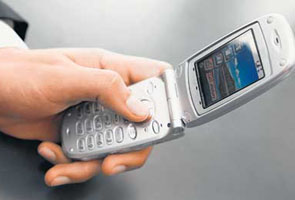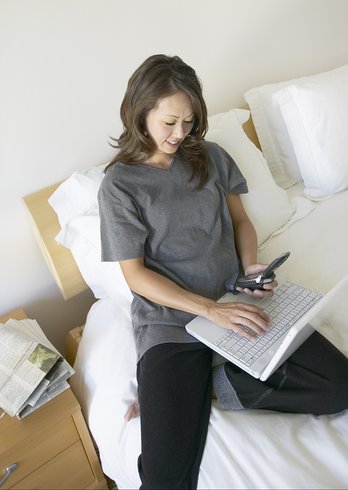Amy Paturel, SELF magazine
You're eating healthier than ever, but your muscles feel flabby, your energy is sapped and your jeans feel increasingly snug, particularly in the belly, hips and rear.
The sad truth: Metabolic rate (the number of calories we burn in a day) plummets as we age, decreasing about 1 percent each year after we hit 30. But research shows there are things you can do to help combat metabolic slowdown.
"When our metabolisms slow down isn't just age-related," explains Christine Gerbstadt, M.D., registered dietitian and spokeswoman for the American Dietetic Association. "Body composition, which is determined by genetics, diet and activity, also plays a major role."
Read on for five ways to keep your fat-burning furnace humming.
Related: The Ultimate Bikini Body Workout
1. Build muscle: Since fat is burned in your muscle, you want to activate as many muscle fibers as possible. Weight training increases lean muscle mass, which raises the amount of calories your body uses, even when you're at rest. What's more, since there's less fat in your body (and your muscles), blood moves better so you have more energy -- without eating more food. So if you haven't been incorporating strength training into your fitness routine, now is the time to start!
2. Start eating: "Your body is a 'refuel as it goes machine,' which simply means it needs to be consistently fed to provide energy to live," explains Mark MacDonald, author of the bestselling book Body Confidence. "This type of consistent feeding stabilizes your blood sugar levels and creates internal hormonal balance" -- and that keeps you from packing on the pounds. His advice: Eat within an hour of waking to kick-start your metabolism. Then keep eating every three to four hours ending an hour before bedtime.
3. Nosh on protein at every meal and snack. Protein has a greater metabolic boost than fat or carbohydrates. Biting, chewing, swallowing and digesting food takes energy -- it's known as the thermic effect of food and it can burn up to 30 percent of the calories on your plate. The more complex the food (think steak, legumes and fibrous vegetables), the more calories you burn as it travels through the digestive tract. Protein also contains leucine, an amino acid that prevents muscle loss when you're dieting. A simple strategy: For a quick and easy snack, keep peanuts in your pocketbook, trail mix in your desk drawer and hard-boiled eggs in the fridge.
See Also: 12 Ways to Think Yourself Slim
4. Get moving: Interval training with bursts of high intensity cardio will stoke your metabolic rate and keep it humming for hours. So instead of logging in your regular half-hour on the treadmill at a steady 4.5 mph pace, try the interval option or hit the road and take advantage of changes in the terrain. Run in the sand or up hills and use landmarks to signify a change of pace. And squeeze in extra calorie burning whenever you get the chance, advises Gerbstadt.
5. Drink water: Studies show that people who drink 8-ounce glasses of water eight to 12 times a day have higher metabolic rates than those who drink four. Want to lose an extra 6.6 pounds a year? Drink half a liter of water before breakfast. According to researchers at Virginia Tech in Blacksburg, Va., people who downed water before their first meal of the day consumed an average of 75 fewer calories at breakfast than those who didn't drink up first.
You're eating healthier than ever, but your muscles feel flabby, your energy is sapped and your jeans feel increasingly snug, particularly in the belly, hips and rear.
 |
| Health Tips: 5 Ways to Keep Your Metabolism Up |
"When our metabolisms slow down isn't just age-related," explains Christine Gerbstadt, M.D., registered dietitian and spokeswoman for the American Dietetic Association. "Body composition, which is determined by genetics, diet and activity, also plays a major role."
Read on for five ways to keep your fat-burning furnace humming.
Related: The Ultimate Bikini Body Workout
1. Build muscle: Since fat is burned in your muscle, you want to activate as many muscle fibers as possible. Weight training increases lean muscle mass, which raises the amount of calories your body uses, even when you're at rest. What's more, since there's less fat in your body (and your muscles), blood moves better so you have more energy -- without eating more food. So if you haven't been incorporating strength training into your fitness routine, now is the time to start!
2. Start eating: "Your body is a 'refuel as it goes machine,' which simply means it needs to be consistently fed to provide energy to live," explains Mark MacDonald, author of the bestselling book Body Confidence. "This type of consistent feeding stabilizes your blood sugar levels and creates internal hormonal balance" -- and that keeps you from packing on the pounds. His advice: Eat within an hour of waking to kick-start your metabolism. Then keep eating every three to four hours ending an hour before bedtime.
3. Nosh on protein at every meal and snack. Protein has a greater metabolic boost than fat or carbohydrates. Biting, chewing, swallowing and digesting food takes energy -- it's known as the thermic effect of food and it can burn up to 30 percent of the calories on your plate. The more complex the food (think steak, legumes and fibrous vegetables), the more calories you burn as it travels through the digestive tract. Protein also contains leucine, an amino acid that prevents muscle loss when you're dieting. A simple strategy: For a quick and easy snack, keep peanuts in your pocketbook, trail mix in your desk drawer and hard-boiled eggs in the fridge.
See Also: 12 Ways to Think Yourself Slim
4. Get moving: Interval training with bursts of high intensity cardio will stoke your metabolic rate and keep it humming for hours. So instead of logging in your regular half-hour on the treadmill at a steady 4.5 mph pace, try the interval option or hit the road and take advantage of changes in the terrain. Run in the sand or up hills and use landmarks to signify a change of pace. And squeeze in extra calorie burning whenever you get the chance, advises Gerbstadt.
5. Drink water: Studies show that people who drink 8-ounce glasses of water eight to 12 times a day have higher metabolic rates than those who drink four. Want to lose an extra 6.6 pounds a year? Drink half a liter of water before breakfast. According to researchers at Virginia Tech in Blacksburg, Va., people who downed water before their first meal of the day consumed an average of 75 fewer calories at breakfast than those who didn't drink up first.




























































